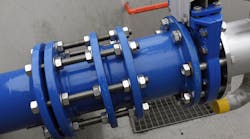This article was updated March 22, 2023. It was originally published March 28, 2016.
RELATED
How External Loads Affect Bolted Joints
How Internal Loads Affect Bolt Preload
A Simpler Way to Predict Bolt Preload
One of the most critical factors in determining the reliability of a threaded-fastener joint is the force the tightened fastener exerts on an assembly, which is known as preload. And preload depends on several variables: fastener material, finish, head style and lubrication.
This complexity means there is no simple, 100% reliable way to calculate the exact amount of preload needed in an application. Fortunately, there are equations that can assist in understanding the relationship between preload and three of the more important factors in threaded joints: bolt load, tensile stress and tightening torque.
Here’s a closer look at those equations.
The tension on a fastener for a given preload and external load is:
Pt = Pi = Pe(Ks/(Ks + Kc))
where Pt is the total bolt load (lb), Pi is the preload (lb), Pe is the external payload (lb), Ks is the screw spring constant (lb/in) and Kc is the assembly spring constant (lb/in).
This equation likely errs on the low side, but it’s accurate enough for most joints. And it is intended only as a guide because it ignores factors such as bending, heating and impact loading.
When fasteners are torqued to increase preload, the torsional stresses this places on them lower the tensile force they can exert before yielding. The total tensile stress felt by the bolt is:
St= Pt/2A + ((Pt/2A)2- (tr/J)2)0.5
where St is the tensile stress felt by bolt (psi), Pt is the total bolt load (lb), A is the thread stress area (in2), t is the torsion felt by screw (lb-in), r is the radius and J is the polar moment of inertia (pi*r4/2).
The amount of torque needed to properly tighten the fastener is estimated from the empirical expression for the fastener:
T = KDPt
where T is the tightening torque (lb-in), K is a constant from 0.05 to 0.35, D is the nominal screw diameter (in) and Pt is the total bolt load (lb).
K is normally about 0.2 for black screws. For lubricated fasteners or those sporting cadmium platings, K is about 0.15. Unlubricated zinc-plated screws can have K’s as high as 0.35.
For rigid steel parts, the conservative practice is to tighten fasteners to 75% of their yield. Less torques should be applied on flexible joints, joints with gaskets and assemblies that will be exposed to high temperatures.
These equations may help designers determine the right preload which can extend the joint’s fatigue life. In a typical rigid assembly, an external load less than the preload barely changes the fastener’s tension. In fact, the fastener won’t fail in fatigue even if the load is repeatedly applied. However, an external cyclic load higher than the tension generated by the preload can cause fatigue failure.
For example, consider a a socket screw with a tensile strength of 180,000 psi and an average endurance limit of 15,000 psi. This means the fastener will withstand a one-time stress of 180,000 psi, but a cyclic stress over 15,000 psi could induce fatigue failure.
The most common way to avoid such failures is to use a larger fastener. However, this generally entails changing hole preparation, tightening methods and assembly fixtures. Frequently, the problem can be solved much more simply by preloading the fastener to above the external load.
